Eating is an obsession in China, and that’s reflected in the abundance of food and drink content on Chinese social media platforms—especially Douyin. Brands in the F&B space can capitalize on the popularity of their niche if they approach KOL marketing the right way. Let’s take a look at some of the Douyin marketing tips and successful campaign strategies employed by f&b brands.
Short-video is perfect for f&b brands
F&B content is well-received across all Chinese social platforms, but short-video is the ideal format for showing off the processes that go into producing, preparing, and enjoying the things we eat and drink.
Douyin is obviously a magnet for KOLs in the food and drink space, as well as for millions of Chinese people seeking out content to tease the taste buds. The ByteDance-owned platform Douyin announced it had reached 400 million daily active users in January 2020. Integration with Taobao via clickable in-video links and banner ads has only further galvanized Douyin’s potency.
The milestone underscored just how powerful the app is, sending a message that brands who aren’t currently utilizing Douyin’s potential should be. Some of the most enthusiastic investors in KOL partnerships on Douyin in 2019 included dairy brands Yili and Mengniu, beverage giants Pepsi and Wang Lao Ji, brewers like Snow and Harbin, conglomerates like Nestle and convenience food brand Kang Shifu. There’s nothing to stop smaller brands from getting involved, even if their pockets aren’t as deep.
Douyin boasts the perfect demographics
This is especially true for brands with a particular interest in the youth market. According to a report by Kasi Data, 54.47 percent of Douyin users with an interest in f&b brands are aged 18 to 24. A further 23.62 percent fall into the 25-30 age group. This clear segmentation around those highly prized younger consumers makes Douyin a dream come true for marketers who can find the right formula for success.
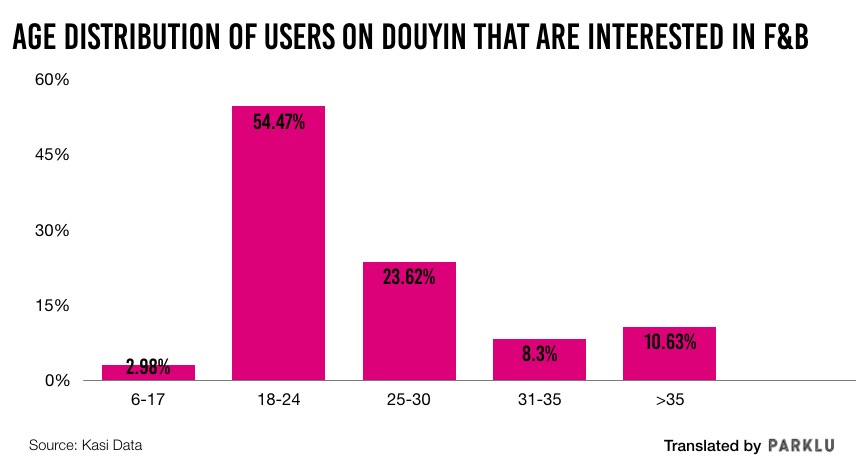
The report’s user profile for the food and drink category found a relatively even balance along gender lines, with a slight 50.18 percent tilt in favor of female users. Other surveys have suggested that Douyin’s user base leans generally more heavily towards female consumers, with a 66-34 split. Female users are also more likely to make purchases using Douyin’s links to e-commerce platforms like Taobao, as well as to native stores.
According to one survey, over 40 percent of Douyin’s user base lives in first and second-tier cities, but that leaves significant representation in the third-tier and smaller cities that many major brands are now pinning their growth projections on.
Respect the algorithm
When it comes to Douyin marketing, F&B brands should understand how content and virality works on Douyin before diving into partnerships with KOLs. The platform is built around ByteDance’s powerful algorithms that use data to learn about the habits and preferences of both users and content creators. The algorithm uses that data to seek out posted videos and identify users it thinks will enjoy those videos. The app automatically serving video after video that it believes the user will enjoy.
This means that when a Douyin user watches one f&b video, the algorithm sends more f&b videos their way. Given the autoplay nature of the user interface, the viewer is likely to consume more food and drink content. This can be useful for brands, and an incentive to stick very specifically to partnering with f&b KOLs, or even KOLs operating in a sub-genre of the food category.
Another important nuance for brands is that partnering with a top-end KOL is no guarantee of virality. Douyin’s algorithms thrive on individual video’s content popularity with users, and that means chasing virality can be an expensive hobby with Top-tier KOLs. According to one report, four of the platform’s top ten best-selling KOLs had fewer than 200,000 followers, which is small by China KOL standards. Brands can get good value from investing in partnerships with multiple small and medium-sized KOLs rather than pinning their hopes on one superstar KOL. A solid Douyin KOL marketing strategy is to collaborate with those who post frequently, with consistent tone and engagement, rather than a viral star who may turn out to be a flash in the pan.
KOL, content, and brand: Finding the right match
When Douyin started out, “short” video meant 15 seconds maximum, and that’s still how a lot of people think of the platform. However, Douyin now allows users to post content up to five minutes in length (and has experimented with 15-minute video privileges for some elite users).
When it comes to food and drink brands partnering with KOLs, some of the same rules apply as with partnerships in any other category and on any other platform. Brands should vet potential influencer partners carefully, only working with KOLs whose content matches the brand in terms of tone, quality, and aesthetic. If e-commerce conversions are the number one KPI, that need should drive the search for the appropriate KOLs.
Consider the contrast between the ethereal rustic aesthetic of Li Ziqi (@李子柒) and the quirkiness of Ms. Yeah (@办公室小野), who cooks a variety of dishes with the unlikeliest pieces of office equipment. Both create cooking-based videos for entertainment rather than instruction, but one is almost meditative while the other is humorous. Both Li and Ms. Yeah are huge Douyin stars, with 35 million and 25 million followers respectively, but their styles are very different.

KOL @李子柒(Li Ziqi )
For some f&b brands, the ideal KOL partnership might mean teaming up with somebody like “Pi Pi Teaches Cooking” (@皮皮教做菜), whose fun cooking class-style demonstrations with an e-commerce element have drawn over 12 million followers. Other brands might be drawn by the competitive eating-style videos of making stars like Liang Wei Xian (@浪胃仙, over 33 million followers) or “Xiang Xiang’s Battle” (@翔翔大作战Fly, over 13 million followers).
Douyin’s algorithm-centric model incentivizes content that responds to the platform’s revolving door of memes, trending topics, challenges, and hashtags. This is all part of the fun, and it’s what keeps users checking in with the app. As part of the vetting process, brands can look to identify KOLs who have proven adept at channeling the latest memes into their output.
Help is at hand for brands who need guidance into the world of KOL partnerships while doing Douyin marketing, PARKLU can advise brands on strategies for managing and analyzing KOLs and help evaluate the suitability of a potential matchup.
Content should be focused, but brands don’t live in silos
It’s wise to pursue an alignment between the KOL’s typical content theme and the brand’s messaging and tone while doing Douyin marketing. However, f&b brands aren’t siloing themselves off from KOLs beyond the realm of food and drink.
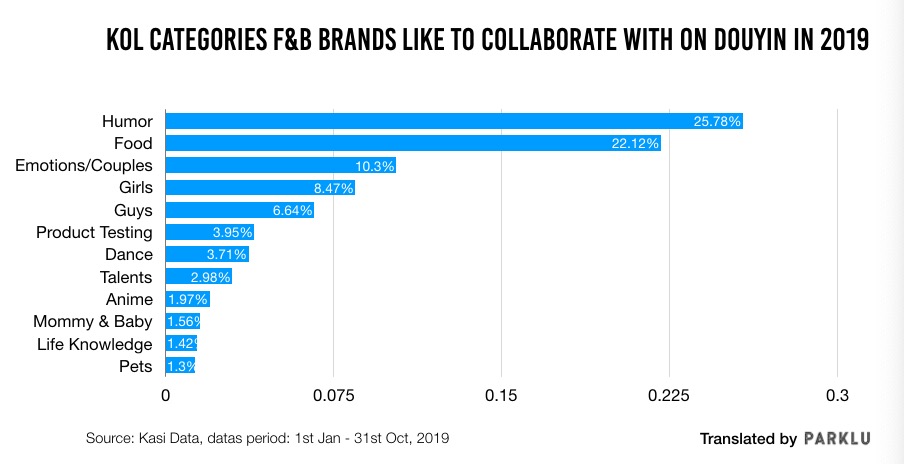
It may seem surprising that in 2019, food and drink brands were most likely to partner with Douyin KOLs in the humor category. Humor accounted for 25.78 percent of the F&B industry’s most sought-after influencers in 2019. However, with 22.12 percent of the total, food KOLs weren’t too far behind. Some of the most popular food KOL for F&B brands to partner within 2019 were @大E特吃, @信口开饭, @颜九的锅, and @浪胃仙 (Liang Wei Xian).

KOL @浪胃仙 (Liang Wei Xian)
One of the most talked-about trends in Chinese social marketing is “vertical + 1”. The idea that content should be aimed squarely at one content niche but should have crossover potential to another. Within Douyin, this means designing content to be tagged under two categories rather than one (see Wang Lao Ji case study, below). F&B brands should look to engage Douyin viewers on the whole experience of eating and drinking—where it happens, with whom, the good and bad memories it conjures— telling a story.
Douyin complements other social tools
A successful KOL-driven Douyin marketing campaign can raise interest and expose the brand to millions of consumers, but the short-video is just one part of an integrated marketing campaign. F&B brands need to weave KOL partnerships on Douyin videos into a package that should also include high-quality WeChat content, product education through the brand’s owned media, and experiential offline marketing.
Douyin Marketing Case: Wang Lao Ji
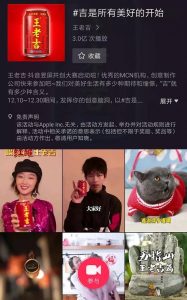
Wanglaoji’s Douyin campaign
Herbal beverage brand Wang Lao Ji scored over 100 million views for its pre-Spring Festival campaign, titled “All good things start with luck” (“luck” referencing the “Ji” in Wang Lao Ji). The campaign partnered with a number of KOLs to kick off a user-generated content campaign. The KOL endorsements inspired their followers to submit their own “ads” for Wang Lao Ji. The wave of user-generated content resulted in almost 3,000 entries, with the winners being judged at a contest in January 2019.
The campaign was a well-rounded example of “vertical +1” marketing, promoting the brand while aligning the messaging to tap into a communal experience, emotion, and storytelling. Wang Lao Ji successfully used KOLs to spark a wave of user engagement and content creation that paid off handsomely.
Douyin Marketing Case: Haidilao
Haidilao successfully combined elements of offline and online marketing with its DIY Douyin recipe. When Douyin users order the DIY recipe, the wait staff bring a special hot pot set that allows the diner to tweak their own hot pot in their own style and film videos to post to the app. The hot pot chain partnered with a number of KOLs to help drive the Douyin marketing campaign, yielding over 2,000 videos from regular users and over 50 million views.


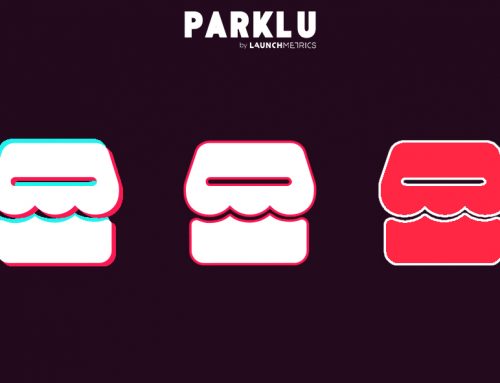
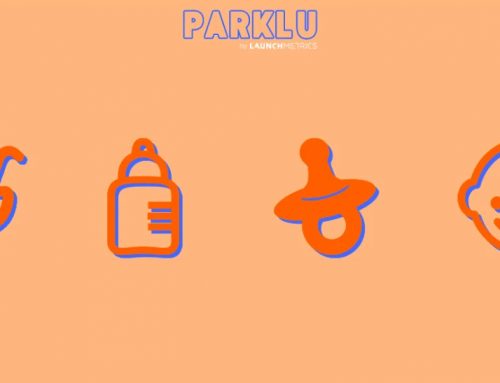


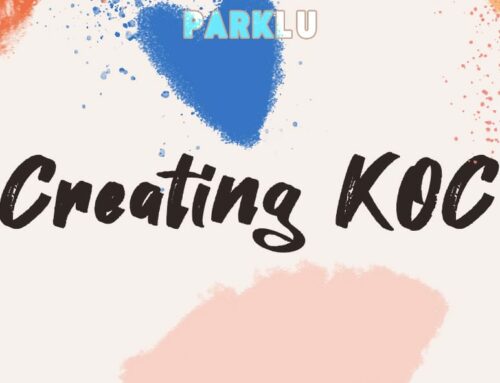

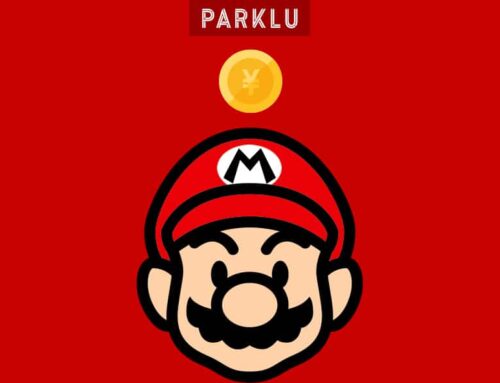
Leave A Comment